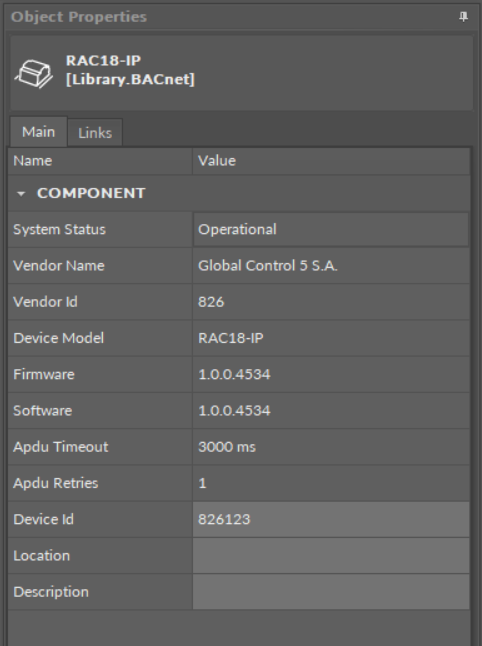In order for the Data Point components to be visible in the BACnet network as BACnet objects, a LocalDevice component is essential. It is the component that allows to configure the device as a BACnet Device object that may be exposed to the BACnet network. The component defines the BACnet properties that are necessary for the BACnet network to recognize the BACnet device and communicate with it.
The LocalDevice component is automatically added and placed under its superior component, the BACnet, and it cannot be removed from the device.
In the Device structure, the LocalDevice component is displayed named according to a device's name saved in the Platform component (generated there automatically based on the device's model).

The LocalDevice component
The LocalDevice component has the following slots:
-
System Status: shows a current status of the BACnet device. If the BACnet device works properly, its status is Operational.Available information: Operational, Operational ReadOnly, Download Required, Download in Progress, Not Operational, Backup in Progress.
-
Vendor Name: shows a name of the device manufacturer.
-
Vendor Id: shows an identification number of the device manufacturer that is provided by the BACnet parent organization, in order to enable transferring non-standard messages via the BACnet network. The RAC18-IP manufacturer's vendor id is 826.
-
Device Model: shows the device model read from the device itself.
-
Firmware: shows the firmware version currently installed on the device.
-
Software: shows the OS software version currently installed on the device.
-
Apdu Timeout: defines the time the system waits before retransmitting an APDU (application protocol data unit) that requires acknowledgment, for which no acknowledgement has been received.
-
Apdu Retries: Defines the maximum number of APDU retransmissions.
-
Device Id: represents the device identification within the BACnet network; by default, the value is set to 826123.
-
Location: allows to enter the device's specific location, in order to facilitate its identification in the user's application.
-
Description: an additional detailed information about a component that may be freely described by the user; the description may contain individual coding, defined in the user's system documentation, meter's or sensor's location, or any other information the user finds applicable.

The LocalDevice component's slots
